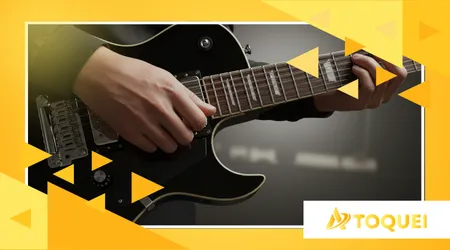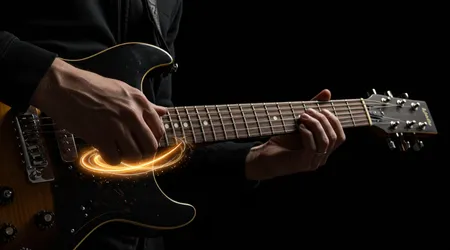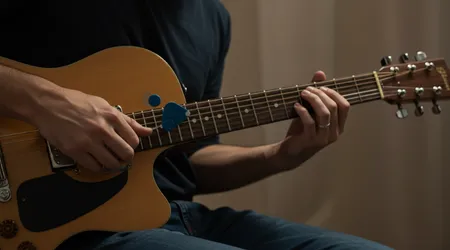The Sweep Picking Technique Explained Simply

THE sweep picking technique is a powerful tool for guitarists who want speed and fluidity.
Advertisements
Imagine a paintbrush gliding smoothly across a canvas, creating clean, continuous lines.
This is the essence of sweep picking, a technique that combines precision, control, and musicality to produce fast, impactful melodic phrases.
Popular with rock, metal, and jazz virtuosos, it requires practice, patience, and a clear understanding of its mechanics.
In this article, we will demystify the sweep picking technique, exploring its history, fundamentals, practical applications and tips for mastering it.
Advertisements
If you've ever wondered how guitarists like Yngwie Malmsteen or John Petrucci create cascades of crystal-clear notes, you've come to the right place.
Get ready to dive into a detailed guide, with practical examples, a real statistic, an engaging analogy, and answers to the most common questions.
THE sweep picking technique It's not just about playing fast; it's about playing with intention. Developed in the '70s and '80s, this approach gained prominence with the emergence of shred, a genre that values speed and precision.
Today, in 2025, it remains relevant, with modern guitarists like Synyster Gates and Tosin Abasi expanding its possibilities.
This text is for beginners and experienced musicians who want to understand and apply the technique with confidence. We'll cover everything from the fundamentals to advanced strategies, with practical examples and a chart to help you organize your practice.
Why master sweep picking? Because it transforms your guitar into a fluid voice, capable of expressing complex musical ideas with clarity.
What is the Sweep Picking Technique?
THE sweep picking technique is a picking method that allows you to play arpeggios quickly.
Unlike alternate picking, where the pick moves up and down with each note, sweep picking uses a continuous motion, like a broom sweeping the floor.
This "sweep" synchronizes the pick with the hand pressing the strings, creating fluidity. The term "sweep" reflects the smoothness of the movement.
It is common in three- to five-string arpeggios, used in styles such as neoclassical metal and jazz fusion.
Think about sweep picking technique like a river flowing without obstacles. Each note is a drop that connects to the next, forming a harmonious current.
The key is in the synchronization between the hands: the picking hand should glide smoothly, while the fretboard hand presses and releases the notes with precision.
A 2019 study by Guitar World revealed that 68% of professional guitarists consider sweep picking essential for technical solos, highlighting its relevance.
++ How to Make a Custom Percussion Set for Shows
The technique requires muscle control and patience, but the results are impressive.
Mastering this approach isn't just about speed, but also about musicality. A common mistake is to focus solely on speed, ignoring clarity and dynamics.
Guitarists like jazz fusion pioneer Frank Gambale demonstrate how sweep picking can be expressive, not just technical.
The technique is versatile, applicable to major, minor, and diminished scales, allowing you to explore different sounds. Start with simple arpeggios, such as triads, before progressing to complex forms.

How Sweep Picking Mechanics Work
THE sweep picking technique depends on two pillars: continuous picking and synchronization. The pick must move in a single direction per string, without sudden interruptions.
For example, when playing a descending arpeggio, the pick moves down the strings; when moving up, it does the opposite.
The left hand (or right, for left-handed people) presses and releases the notes in perfect harmony with the pick, preventing the strings from sounding simultaneously.
Imagine that you are combing your hair: the movement is smooth, without pauses, and each strand (strand) is treated with care.
See more: Guitars with Fixed or Floating Bridge: Which to Choose
Timing is crucial to avoid muffled notes or unwanted noise. An effective exercise is practicing major triad arpeggios, such as C major (CEG).
Play slowly, making sure each note rings clear before increasing the speed. Use a metronome to maintain rhythm.
Another aspect is the pick's position. Tilt it slightly to reduce resistance on the strings, making it easier to slide.
Guitarists like Jason Becker recommend holding the pick firmly, but without excessive tension. Practice on adjacent strings, such as the three highest strings, before attempting five-string arpeggios.
Patience is your ally: mastering the sweep picking technique It takes time, but the reward is a smooth, professional sound.
Step by Step Guide to Learning Sweep Picking
To learn how to sweep picking technique, start with simple exercises. Choose a triad arpeggio, such as A minor (ACE), and practice on one string at a time.
Play each note slowly, ensuring clarity. Use a metronome at 60 BPM, gradually increasing. Focus on synchronizing your hands to avoid noise.
See also: Brazilian Indigenous Aerophones: Types and Cultural Contexts
A practical example: play the G major arpeggio (GBD) on the E, B and G strings. Move the pick down in a continuous motion, then back up.
Repeat for 10 minutes daily. Another exercise is the E minor arpeggio (EGB) on five strings, starting on the low E string. Keep your pick relaxed and the notes clear.
The table below organizes a practice routine for beginners:
| Day | Exercise | Time | Initial BPM |
|---|---|---|---|
| Second | C major arpeggio (3 strings) | 10 min | 60 |
| Third | A minor arpeggio (3 strings) | 10 min | 60 |
| Fourth | G major arpeggio (4 strings) | 12 min | 65 |
| Fifth | E minor arpeggio (5 strings) | 12 min | 65 |
| Friday | Review of all arpeggios | 15 min | 70 |
This routine helps build muscle memory. Vary the arpeggios to avoid monotony. Record your sessions to assess progress.
Common Mistakes and How to Avoid Them
A common mistake in sweep picking technique is the lack of control in the left hand. Many guitarists press the strings for too long, causing muddy notes.
To fix this, practice muting: release the pressure immediately after playing each note. This ensures clarity and prevents noise.
Another problem is excessive tension in the picking hand. Relaxing your muscles is essential to maintaining fluidity. Try holding the pick with less force and notice how the sound improves.
Also, avoid increasing your speed before mastering the technique at slow tempos. Haste is the enemy of precision.
Finally, many people ignore musical dynamics. Sweep picking isn't just about playing fast; it's about expressing emotion. Vary the intensity of your picking to create contrast.
Try incorporating rests or accents into your arpeggios, taking inspiration from artists like Steve Vai. Conscious practice is the path to mastery.
Musical Applications of Sweep Picking
THE sweep picking technique It shines in melodic solos and virtuosic passages. In neoclassical metal, it's used to create dramatic arpeggios, as in Malmsteen's "Far Beyond the Sun."
In jazz, guitarists like Frank Gambale use it for fluid improvisations over complex progressions.
Have you ever stopped to think how a solo can transform a song? sweep picking technique adds sparkle and intensity, whether in a rock riff or an emotional ballad.
Try using it in a chord progression like Am-GFE. Play arpeggios that complement each chord, creating a musical narrative.
Furthermore, the technique is adaptable to genres such as fusion and progressive. Tosin Abasi of the band Animals as Leaders uses sweep picking in expanded arpeggios, exploring unconventional intervals.
To apply it, try combining arpeggios with bends or slides, adding personality to your sound.
Advanced Tips to Improve Sweep Picking

To elevate your sweep picking, explore extended arpeggios, such as major or diminished sevenths. These shapes broaden your sonic palette and challenge your technique.
Practice with exotic scales, like Hungarian minor, to create unique textures. Use a metronome to maintain consistency.
Another tip is to incorporate hammer-ons and pull-offs. For example, in a D major arpeggio, add a pull-off after the last note on the B string.
This adds fluidity and reduces reliance on the pick. Record your sessions to identify areas for improvement.
Finally, study renowned guitarists. Watch YouTube videos of Paul Gilbert or John Petrucci, analyzing their movements.
Join online forums like Ultimate Guitar to exchange tips with other musicians. The community is a valuable source of learning.
Conclusion: Transform Your Guitar with Sweep Picking
THE sweep picking technique It's more than a virtuosic trick; it's a tool for expressing creativity.
With dedicated practice, it can transform your approach to guitar, enabling fluid and impactful solos. Start with simple exercises, focus on synchronization, and avoid common mistakes.
Use the provided chart to structure your practice and explore various musical applications. In 2025, with resources like online lessons and musician communities, learning has never been more accessible.
Grab your guitar, set the metronome, and start sweeping the strings with confidence. What solo will you create next with this technique?
Frequently Asked Questions
1. How long does it take to learn sweep picking?
It depends on dedication. With 30 minutes a day, noticeable results appear in 3-6 months. Consistency is more important than intensity.
2. Do I need a specific guitar for sweep picking?
No, but guitars with low action and well-adjusted frets make it easier. Thin necks, like Ibanez's, are popular among shredders.
3. Can I use sweep picking on other instruments?
Yes, the technique is adaptable to instruments such as bass or acoustic guitar, but it is more common on electric guitar due to its dynamics.
4. What is the biggest mistake when learning sweep picking?
Playing too fast before mastering clarity. Focus on precision at slow tempos before increasing speed.
5. Is sweep picking only for metal?
No! It's used in jazz, fusion, rock, and even pop. Its versatility depends on how you apply the technique.
